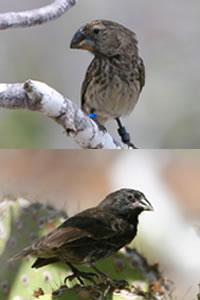 The large ground finch (top) has battled it out with the medium ground finch for big seeds, leading the medium ones to trend towards smaller beaks (bottom).© B. Rosemary Grant
The large ground finch (top) has battled it out with the medium ground finch for big seeds, leading the medium ones to trend towards smaller beaks (bottom).© B. Rosemary GrantCompetition between two species of finch in the Galápagos has caused the beak size of one species to shrink, and scientists have watched it happen. Detailed observations of the birds, which Darwin famously studied while formulating his theory of evolution, have provided one of the best descriptions of a characteristic trait evolving in the wild.
In a paper appearing in this week's issue of Science1, Peter and Rosemary Grant, both biologists at Princeton University, New Jersey, describe the struggle between the medium ground finch (Geospiza fortis) and the large ground finch (Geospiza magnirostris).
In the harsh environment of the tiny Galápagos island Daphne Major, the medium ground finch subsists mainly on small seeds. Members of the population with sufficiently large beaks, however, have been able to tackle the bigger seeds of a low herbaceous plant called Tribulus cistoides.
These larger-beaked birds met with competition upon the arrival of the bigger G. magnirostris, a few members of which flew to the island in 1982 and set up a colony. Their universally large beaks made cracking into big seeds an easy job.
A Tribulus seed is like "an orange wedge with two great big long spines sticking out the back of it," says Dolph Schluter, a zoologist at the University of British Columbia in Vancouver, Canada, who worked with the Grants when he was a graduate student. "The medium ground finches twist off the ends, but it takes a lot of force to do it. G. magnirostris has no problem with it."
The two species lived fairly happily together for many years, until two factors forced the birds into harsh competition.
Tough times
The population of large finches grew, until there was enough of them to be battling with the medium finches, who were also going after Tribulus seeds. And then two years of drought, in 2003 and 2004, dramatically reduced the food supply, causing both populations to plummet as birds died of starvation.
In these mean conditions, the medium finches with smaller beaks had an advantage over those with big beaks, as they could more easily suck up smaller seeds that weren't being gobbled by the large finches.
"Small-beaked birds survived better than the large-beaked birds, to a strong extent, during the drought," says Peter Grant. And that trait was then passed down to the next generation.
In 2004 and 2005, the Grants observed a strong shift towards smaller beak size among the medium ground finch. The birds' feeding patterns changed too: they went for the large seeds only half as often as in previous years.
Seen, not inferred
This kind of evolution, in which a characteristic of two similar species diverges due to competition over resources, is called character displacement. The idea has become widely accepted thanks to a number of well-detailed studies, says Jonathan Losos, a biologist at Washington University, St Louis.
ADVERTISEMENT
"People have inferred character displacement," says Jeffrey Podos, an associate professor of biology at the University of Massachusetts, Amherst. "But to actually see it as it happens is quite a triumph. To be in the right place at the right time to observe something like this is really just incredible."
Peter and Rosemary Grant have been studying finches on Daphne Major for more than thirty years. Just north of the better known and more hospitable island of Santa Cruz, Daphne Major is uninhabited. "There is barely enough flat ground to pitch a tent," says Podos. The small size of the island, and relative lack of diversity in animal and plant life made it possible for the Grants to monitor the population size and feeding habits of finches in intimate detail.
"This is the most thorough study of character displacement ever conducted," says Losos. "It will make its way instantly into general biology textbooks."
Visit our caughtintheact.html">newsblog to read and post comments about this story.
University of Massachusetts, Amherst
